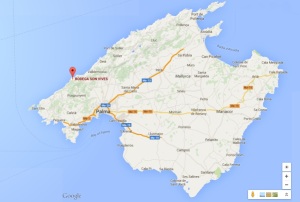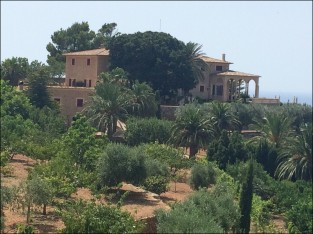“Millionaire views paired with artisanal winemaking techniques”

Banyalbufar, Mallorca, Spain
www.sonvives.com
[Website in Castilian and Catalan only]
Featuring the rare native Malvasia grape, beautiful Celler Son Vives opened in 2003, and Mallorcan proprietor Toni Darder Alorda answers the phone himself, in Spanish – because as of this writing the main number for this Tasting Room is his cell phone! A small winery, Son Vives produces approximately 15,000. bottles each year, with four labels. They distribute mostly to restaurants on the island, and to select retail stores in the lovely capital city of Palma. The location and views at Son Vives are stunning, and the coastal climate ideal for the rare Malvasia grape which is the signature of all Banyalbufar wineries, and their reason for existing in this unique spot.
Mariona was just locking the gate when we pulled up at 5:00, and although she had a fair drive home to Palma, she readily agreed to reopen the tasting room for us. We walked together along a broad terrace amidst olive trees, lavender bunches, and amazing views of the terraced coast and azure sea, to a small outside counter-style tasting bar where Mariona poured from inside the shady Bodega. Tasting room ambiance just doesn’t get better than this!
We tried 1 mono variety, 100% Malvasia of course, and 2 blends. Sadly, we were not able to tour the bodega production area because of how late we were. However, the tasting bar is on a lovely veranda, which overlooks the Mediterranean, and the views are exquisitely beautiful! In fact, it overlooks the gorgeous Celler Ca’n Pico estate, and if we didn’t know better, we would have thought those vines belonged to Son Vives. As Mariona poured, we noticed a menu on the wall showing that they can make Pa amb Oli here (bread & olive oil with sliced meats or cheeses) to pair with their wines. We’d highly recommend that, but book in advance. Or bring your own tasting-complementary picnic for the bottle you’ll want to buy here after tasting! The tasting area is right off the ‘main’ road, but you feel like a millionaire enjoying these wines with a view. Combining a lunchtime tasting here on the veranda with an afternoon tasting at Ca’n Pico would make for a great day!

As we sipped their three tasting wines, we learned their property always had vineyards which were for family consumption. In 2003 the family transitioned to commercial production without losing the artisanal techniques, including hand picking the maturing Malvasia grapes.
Celler Son Vives is part of the Island group Vi de la Terra Serra de Tramuntana which is comprised of 18 municipalities in the protected UNESCO World Heritage Serra de Tramuntana, reaching from Cap de Formentor to Andratx. It is characterized by the famous stone “bancales” which are agricultural terraces mostly made during the Moorish occupation which lasted approximately 500 years from the 700s to 1200s AD. Built of local stone and rich soil, the terraces prevent soil erosion and allow the Malvasia vine roots to grow deep in well draining guarded soil. The North-facing coast offers maximum sun time with cooler temperatures, but it is more difficult to pick and creates differing ripening times – therefore requiring a lot of individual care!
While Celler Son Vives grows their Malvasia in this vineyard, they also make two blends, a white and a red, and those grapes are brought here for production from the hotter and dryer central island plain. Please see the tasting notes for more details on that!
Doors closing
Hearts opening
Bottles cracked
Lips smacked
Gorgeous
Mariona was very knowledge about the wines, and we would have enjoyed touring the production areas and asking her more questions about their history and blends. However, we were very pleased with the kindness she showed us so late on a Friday evening!
We will have to return again and taste and tour with more time!
How to get there:
As you leave Banyalbufar heading West in direction Estellencs you will see a sign for a parking lot on the right. You can park there and walk up or continue driving 10m and will see the sign of Son Vives from the road with 3 or 4 parking spaces out front. Very easy to find.
See Wines Tasted at Son Vives: Click here
### Celler Son Vives ###

































